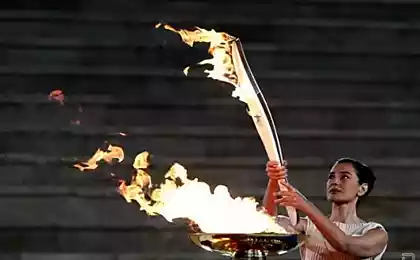3112
History of the Olympic torch (66 photos)
Kindle Fire tradition existed in ancient Greece: it reminded of the heroism of Prometheus, who stole fire from Zeus and gave it to people. In the history of the modern Games, the Olympic flame was first lit in 1928 in Amsterdam, and in 1936, before the games in Berlin, held the first Torch relay - the idea of it belonged to Joseph Goebbels. Rite torch relay is the best suited for ideological doctrine of the Nazis - and simultaneously embodied several ideas and symbols.

1. Berlin. Pervyynah. Design Berlin Olympics torch came up with sculptor Walter Lemke. The famous company Friedrich Krupp produced 3840 torch relay for the 3331 party. Torches length of 27 cm and weighing 450 grams were made from stainless steel. In the event of the fire has been flared, an additional fuse.
Torch 1936:

The Olympic flame was lit by the sun's rays using a concave mirror in Olympia, Greece, and taken to Berlin for more than 3,000 runners. German athlete Fritz Shilgen (Fritz Schilgen) lit the Olympic flame at the opening ceremony of the XI Olympic Games at the stadium, which is decorated with a swastika flags.

2. London. After this grand show, as you know, all was not up to the Olympics - and the following games have been held in 1948 in London. Despite the ... decided to repeat the ritual. The design of the torch invented by Ralph Lavers, a fan of the classic style of architecture. Were made two versions of the torch: one aluminum with pills inside the fuel, and the second specifically for the final stage of the relay at the stadium of stainless steel. It was burning magnesium, which allows you to see the fire, even in bright daylight.
Torch 1948:
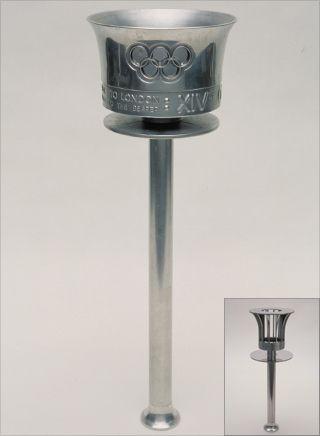
British athlete John Mark (John Mark) brought the Olympic torch on "Empire steydium" at Wembley and inaugurated the Olympic Games in 1948.
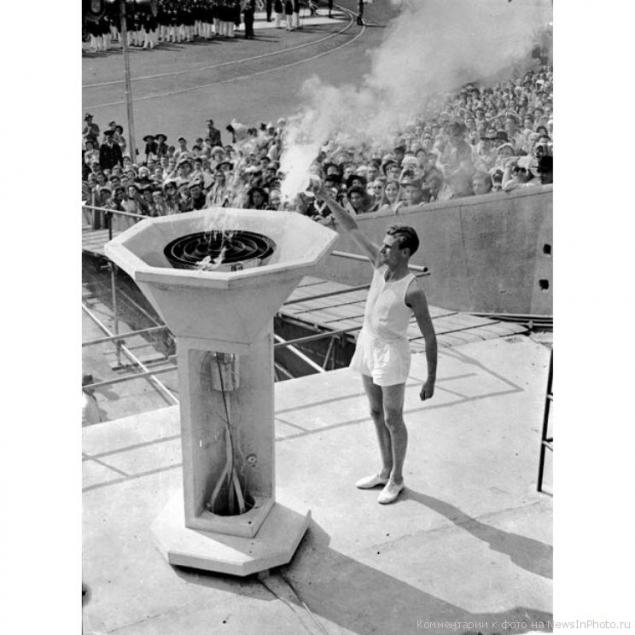
3. Oslo. The first torch relay of the Winter Games did not begin in Greece, as usual, and in the Norwegian town of Morgedal popular with ski jumpers and slalom. Norway has long been a tradition at night skiing with torches in their hands, and skiers from Morgedal decided to bring the fire in Oslo.
Winter Games Torch 1952:

Handle each of the 95 torches made for the relay, had a length of 23 cm, and the cup was depicted arrow, as if connecting Morgedal and Oslo.

4. Helsinki. The most cost-effective - the Finns. For the Helsinki Olympics were made only 22 of the torch, but they were applied in 1600 gas cartridges. One such cartridge lasted for about 20 minutes of burning, so they had to change quite often. Men who participated in the relay, ran one kilometer, the woman - a little less. Silver bowl weighing 600 g was pushed over the hilt of birch wood. After the Olympic torch as mementos received various Olympic committees and sports organizations.
Torch 1952 Summer Games:

Finnish runner Paavo Nurmi (Paavo Nurmi) slowly lights the Olympic flame at the opening ceremony of the Summer Games at the stadium in Helsinki:

5. Cortina. Olympic flame for the Games held in northern Italy, in Cortina d'Ampezzo, was lit at the temple of Jupiter, the Roman Capitol, as shortly before the capital of the Summer Olympics in 1960 was chosen Rome.
Winter Games Torch 1956:
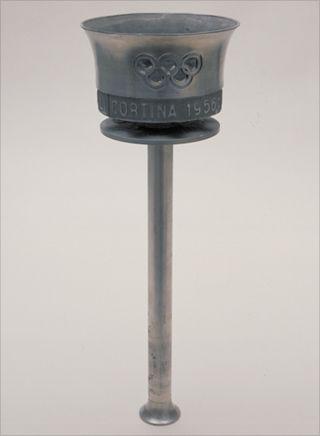
First with the Olympic flame ran athlete Adolfo Consolini. Part of the baton passed on roller skates.
6. Melbourne. Once in the two countries. Perhaps one of the originals of the Australian torch became Ralph Laversa design, created for the London Olympics in 1948. Equestrian competitions were held in Stockholm, so the Olympic flame traveled in Australia and Sweden.
Torch 1956 Summer Games:

To Melbourne 3118 runners carried the fire, made his way to the 20470 km in length. Distance of one mile each athlete takes different time, as some sections of the path passed over rough terrain in the tropics.

7. Squaw Valley. Honorable mission organization spectacular opening and closing ceremonies of the Winter Olympics in California, as well as various events throughout the Games has been entrusted to the company Walt Disney. One of its artists, John Hench, invented the torch design, using elements of the London and Melbourne torches.
Winter Games Torch 1960:

1960 - Olympic Games in Squaw Valley. Torch lit in the valley of Morgedal in Norway, the home of the legendary Norwegian skier Sondre Norheyma then delivered in the United States:
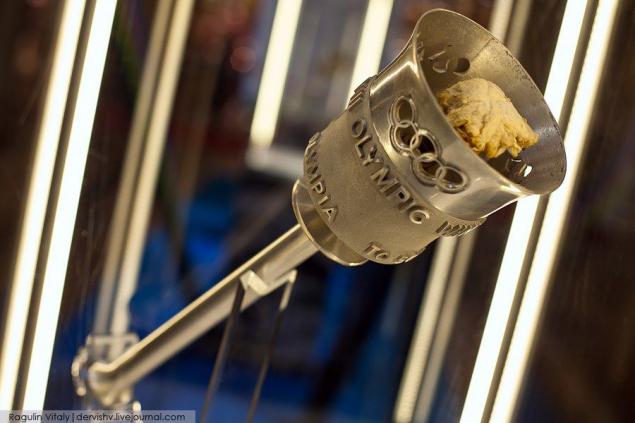
8. Rome. Sleek design aluminum coated bronze torch, weighing 580 g was inspired by its author forms of antique sculptures. Relay started in Greece. Torch carried by that same path that took place once the ancient Greeks established colonies in Sicily and the Apennine peninsula.
Torch 1960 Summer Games:
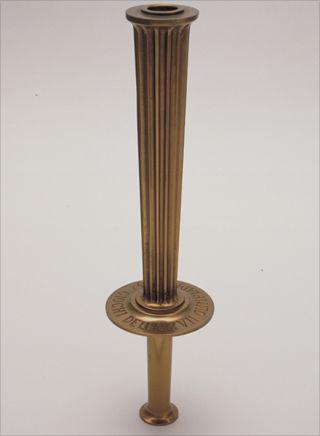
1960: Italian student Giancarlo Peris (Giancarlo Peris) with a torch after lighting the Olympic flame at the opening ceremony in Rome XVII modern Olympics:
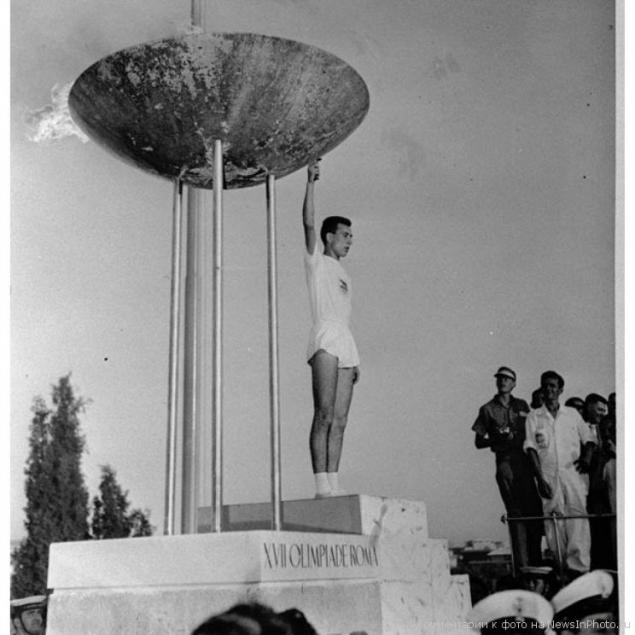
9. The cup with the Olympic flame lit in Innsbruck Winter Olympics Party 1956 skier Joseph Reeder. Torch flown from Athens to Vienna, and then relay - in Innsbruck. Winter in Innsbruck in the year was unusually little snow.
Winter Games Torch 1964:


10. Tokyo. Samurai sword. Torch from Olympia in Tokyo delivered by air, sea and land. In Japan, the flames were separated and carried in four directions, joined together at the end of the relay.
Torch 1964 Summer Games:

The last torch carried Yoshinori Sakai, born in Hiroshima August 6, 1945, the very day when the city atomic bomb was dropped. When he brought the torch on the Tokyo stadium grandstands sprayed scent of chrysanthemums.

11. Grenoble. Travel torch made of bronze and steel in France have passed adventures. Through one of the mountain passes, Puy de Sancy, torchbearer broke literally on all fours because of the strong snow storm. And in the old port of Marseille he carried swimmer, holding the torch above the water at arm's length.
Winter Games Torch 1968:
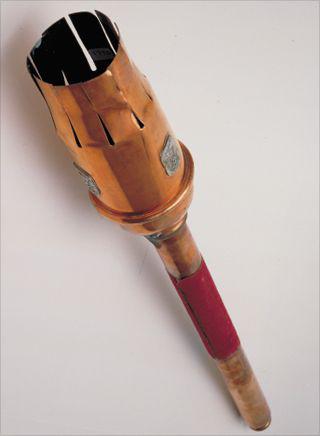
Olympic flame carried more than 5,000 people, the length of the baton was 7222 km. Costume party on the last relay was assigned to the microphone, and at the time of lighting the fire stadium heard the beating heart of an athlete.

12. The most traumatic relay. Externally, all 3000 Mexico City torches to remind beaters for beating eggs. At the top of each of them was engraved volume inscription: "Mexico '68'. Relay took place along the route of Christopher Columbus: from Europe - the New World.
Torch 1968 Summer Games:

In Mexico City, the first time in the history of the Olympics bowl with fire lit woman athlete Enriqueta Basilio. Torches inside solid fuel, contrary to expectations, it was flammable. So easy, in the process, there were several explosions in the relay, and some torchbearers received minor burns.

13. Sapporo. Japan torch carried exclusively young people aged 11 to 20 years. And again, as before the Olympic Games in Tokyo, the Olympic flame divided and carried several routes to be able to welcome as many people in the country. Made of aluminum alloy, in the form of a torch resembled a bowl of ice cream. And the torch, and identical in design cup was invented by the artist Munemiti Yanagi, known for its distinctive butterfly chair.
Winter Games Torch 1972 (handle):

During the Olympic Games in Sapporo in 1972 relay transmission of fire was more than 5,000 km, it was attended by over 16,000 people. The height of the plume - 70, 5 cm:

14. Munich. The main feature of the design of the Games became famous athletes icons designed Aicher broke off. Gas torch was made of stainless steel and has passed a test of endurance in different weather conditions except extreme heat. When on the way from Greece to Germany, the temperature reached 46 degrees Celsius, it was necessary to use a special sealed torch.
Torch 1972 Summer Games:

15. Innsbruck. This torch - a relative of Munich. He, too, like a sword, top decorated with Olympic rings. This torch lit just two bowls - as a symbol of what the Winter Olympics held in Innsbruck for the second time.
Winter Games Torch 1976:

Greece torch flown to Vienna, and from there to the capital city of the Games two routes: through the north and south of Austria.

16. Montreal. Space transmission of fire. As the torch would look on television? That is the main question that bothered him designers George and Michel Dallaire Hujoel. To enhance the effect, the designers have put a fire in a black square on the red handle. For the first time in the history of the Olympic flame was moved from continent to continent - from Athens to Ottawa - in the form of a laser beam through a space satellite. And in Canada by an ordinary beam lit the torch that burned olive oil. July 22 bowl with the Olympic flame in the stadium in Montreal extinguished due to hurricane winds. It had to be lit again, using the backup power brought from Greece fire.
Torch 1976 Summer Games:
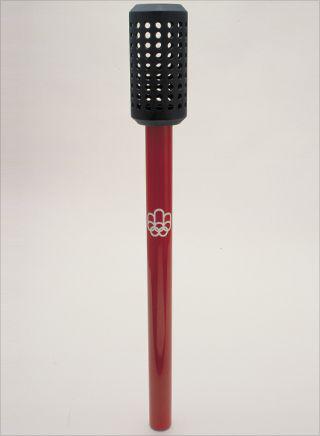
Stefan Prefontan (Stéphane Préfontaine) and Sandra Henderson (Sandra Henderson) lit the Olympic flame at the opening ceremony of the Olympic Games in Montreal:
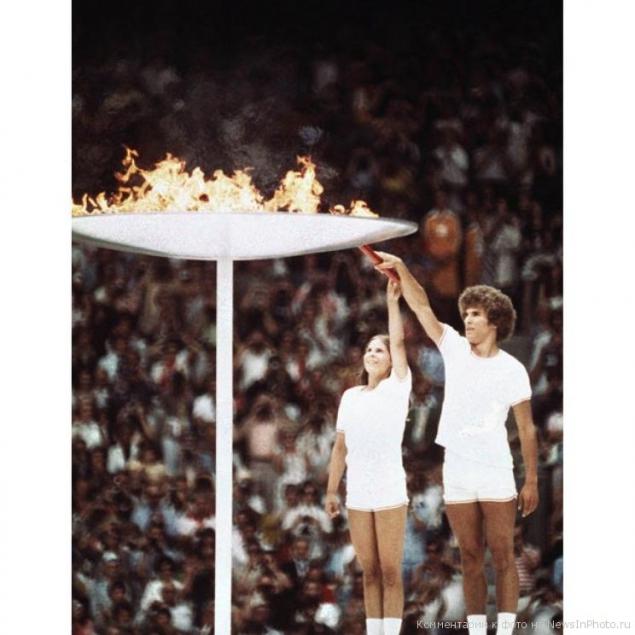
17. Lake Placid. The Olympic torch is regaining the usual form. But for the first time the number of participants was small relay. With a torch ran 26 men and 26 women from all US states. Among them were not only athletes, but also the outstanding representatives of other spheres of activity. The route of the relay started in an area where the British established their first settlement, and went through all the historical regions of the United States.
Winter Games Torch 1980:

18. Moscow. Again, the unusual shape: a silver torch - gold tip and a gold decorative detail on the handle with the emblem of the Moscow Olympics. She served and protective screen. The torch was designed by a group of Leningrad engineers led by Boris Tuchina and patented the invention of the USSR under number 729414. For the Olympic torch relay was made 6200 copies.
Torch 1980 Summer Games:

Initially, the design and manufacture of the torch was commissioned a major Japanese company, which was one of the sponsors of the Moscow Games. The same company was to create and shape for torchbearers. The Japanese took over the work, and have created a wonderful sketch to your beautiful Japanese look.
When Soviet officials saw the torch in the form of cane, they were extremely disappointed ... But our Asian friends apologized and paid a decent penalty - $ 30,000. Time before the start of the Olympic torch relay was little. Manufacturing torch instructed by Leningrad Department of the Ministry of Aviation Industry. They created the torch that carried through the whole world, and athletes from the Olympic Flame is lit at the Luzhniki Stadium July 19, 1980.

The torch was quite comfortable and technologically advanced - 550 millimeters in length and weighing 900 grams. Material - aluminum, steel, gas cylinder of nylon. Honor to make a torch in the main stadium was given triple Olympic champion in the triple jump Victor Saneeva. He carried the torch through the Luzhniki and handed it to basketball player Sergei Belov, who lit the Olympic bowl in Moscow:

19. Sarajevo. The torch was made by the Japanese company Mizuno and resonates with a torch Tokyo Olympics: a small circular platform and a thin rod, which is placed in the burner. Yugoslavia torch carried by two routes. The idea was to relay took place in all major regions of the country.
Winter Games Torch 1984:
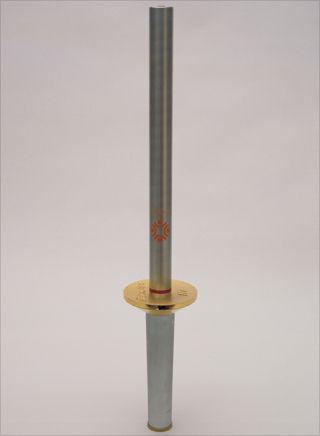
The length was 5289 km relay, the Olympic flame was carried in 1600 torchbearers.

20. Los Angeles. The torch is made of steel with brass and leather trimmed in leather. At the top of the torch is depicted Memorial Stadium in Los Angeles, where he spent the Games not only 1984 but also in 1932. Olympic Torch Relay for the 1984 Games has become almost the most controversial in the history of the Olympic Movement. Organizers sold the right to run their athletes step - 3 thousand dollars per kilometer. This caused an uproar among the Greeks, the founders of the Olympic Games. In addition, two hours after the start of the relay Soviet Union announced that it would boycott the Olympics in Los Angeles in response to the boycott of the Moscow Olympics-Americans in 1980. However, despite the scandals, thousands of people lined up along the route of the relay and welcomed the Olympic flame.
Torch 1984 Summer Games:

Hempfill Gina (Gina Hemphill), granddaughter of Jesse Owens (Jesse Owens) delivers the Olympic torch into the stadium "Colosseum" in Los Angeles:

21. Calgary. Relatively heavy weight of the torch 1, 7 kg was made in the form of the tower, is a landmark in Calgary. The handle of the torch is made of Canadian maple. Bowl itself - alloy steel and aluminum. For the first time in the Olympic torch was engraved motto of the Olympic Games, "Faster, higher, stronger." Made laser pictograms on the handle represented the 10 winter sports on the program of the Winter Olympics. Relay lasted 88 days. In Calgary, carried the torch from the east coast in 10 provinces and two territories.
Winter Games Torch 1988:

More than 7 million applications were received from residents of Canada who wanted to take part in the relay transmission of the Olympic flame during the Olympic Games 1988 in Calgary. A distance of 18 000 km running man 7342.

22. The Seoul Games, the South Korean company has produced a torch made of copper, plastic and leather. This torch design is very similar to its Canadian predecessor. But engraving native Korean: two dragons symbolizing the harmony between East and West. For 22 days the torch distance traveled in 4167, 8 km. Through 21 cities it carried 1,467 athletes with an escort.
Torch 1988 Summer Games:


23. Albertville. This stainless steel torch marked the beginning of the era of extravagant forms by world famous designers. By building his torch attracted famous French Philippe Starck, famous for its furniture and other home furnishings. 10 years before the Games in Albertville Stark came up with the design for the apartment of French President Francois Mitterrand.
Winter Games Torch 1992:
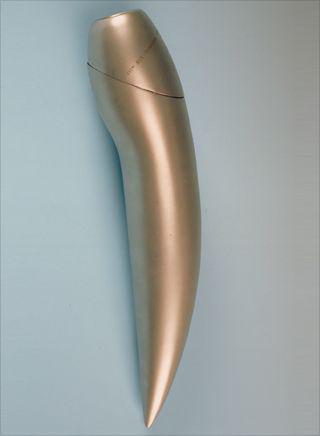

24. Barcelona. Industrial designer from Barcelona Andre Ricard invented the torch, deliberately different from all previous ones. As he spoke, his aim was to give the torch a special "Latin" character & quot ;. Relay passed through 652 settlements, some of the steps in the sparsely populated areas were made by bicycle.
Torch 1992 Summer Games:

Olympic bowl at the stadium named Lewis Companys on Montjuïc was lit archer Antonio Rebollo, Paralympic, let flaming arrows right in the center of the bowl.
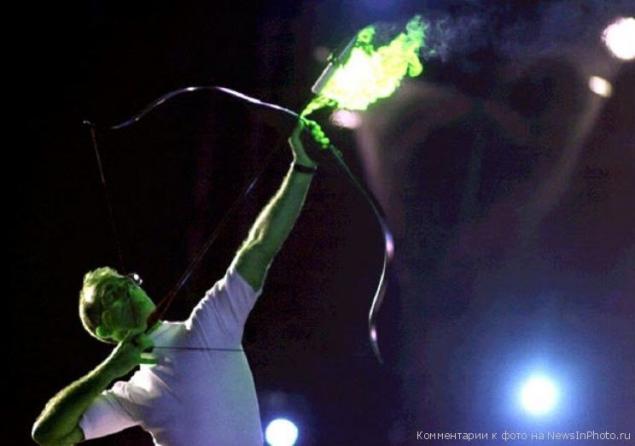
25. Lillehammer. This slim torch passed tests for stability in the most unfavorable windy weather.
Winter Games Torch 1994:
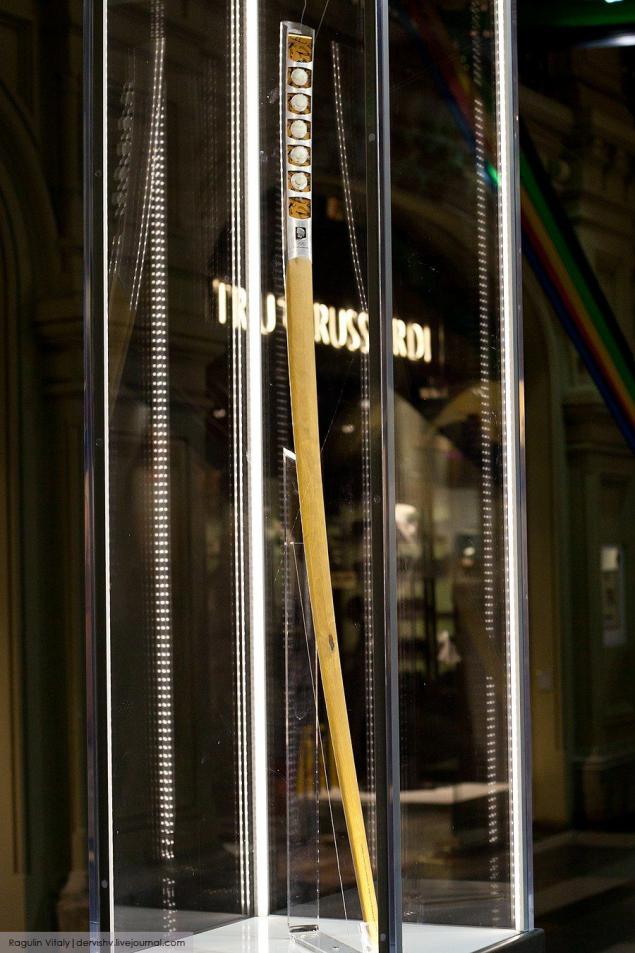
The fact that the stadium has made it Lillehammer ski jumper, holding a torch in the air at arm's length. And again, as before Olimpialoy in Oslo, the fire was lit in Greece is not, as in the Norwegian Mordegale. At this time the torch relay stretched for 12 thousand kilometers. But suddenly the Greeks protested, calling the organizers of the Games return to the Norwegian tradition. As a result of fire from Greece was still delivered to the opening of the Games, and it was from him lit the torch, which was entrusted to a ski jumper.

26. Atlanta. Design Malcolm Greer - a bunch of reeds tied with twine - inspired by the forms of ancient torches. 22 aluminum cane stalk symbolize Summer Olympics, held in recent history. In fact, the stems were 26 such as the Olympics in Atlanta - 26th in a row. But some melted aluminum tubes, and had to urgently correct design of the torch. The handle is made of wood pecan. At the moment, this is the longest in the history of the torch of the Summer Olympics. Atlanta had to light the torch twice: first went out almost immediately, even in Greece.
Torch 1996 Summer Games:
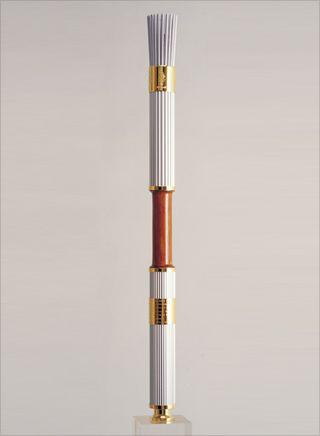
Former boxing champion in the heavyweight division and a gold medal at the Olympic Games in 1960 Muhammad Ali lights the fire at the Olympic Stadium in Atlanta at the opening ceremony of the Games:
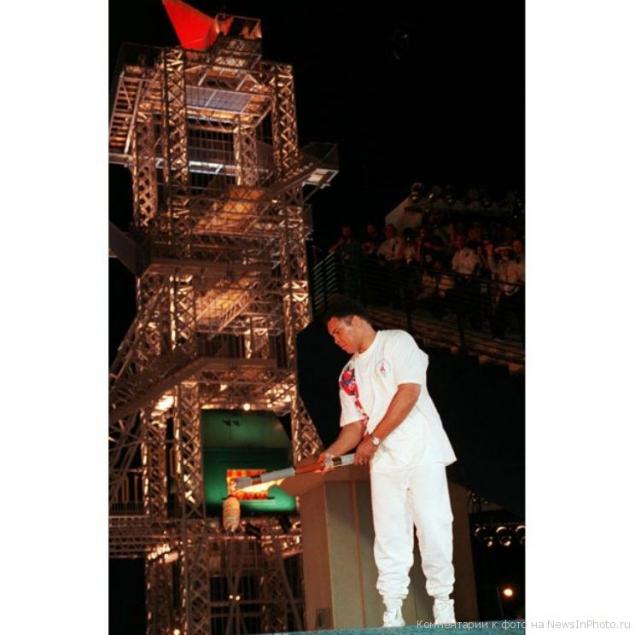
27. Nagano. The torch is made in the image of traditional Japanese Taymatsu torches, but with some modern elements. He was entirely of aluminum, and burned by propane - and was considered the most environmentally friendly of all made so far. The hexagonal shape of the top of the torch symbolizes the snowflake and silver color - winter. Honor to make the Olympic flame into the stadium fell Nagano Briton Chris Moon, lost an arm and a leg in Mozambique, where neutralizes anti-personnel mines. Under a barrage of applause Moon ran around the stadium, despite the fact that instead of one of his legs prosthesis.
Winter Games Torch 1998:
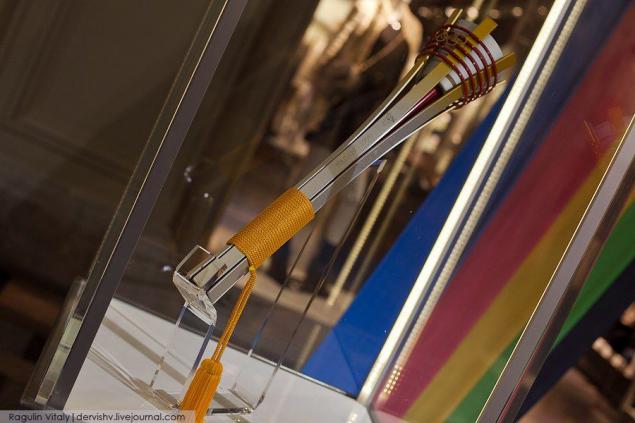
28. Sydney.

1. Berlin. Pervyynah. Design Berlin Olympics torch came up with sculptor Walter Lemke. The famous company Friedrich Krupp produced 3840 torch relay for the 3331 party. Torches length of 27 cm and weighing 450 grams were made from stainless steel. In the event of the fire has been flared, an additional fuse.
Torch 1936:

The Olympic flame was lit by the sun's rays using a concave mirror in Olympia, Greece, and taken to Berlin for more than 3,000 runners. German athlete Fritz Shilgen (Fritz Schilgen) lit the Olympic flame at the opening ceremony of the XI Olympic Games at the stadium, which is decorated with a swastika flags.

2. London. After this grand show, as you know, all was not up to the Olympics - and the following games have been held in 1948 in London. Despite the ... decided to repeat the ritual. The design of the torch invented by Ralph Lavers, a fan of the classic style of architecture. Were made two versions of the torch: one aluminum with pills inside the fuel, and the second specifically for the final stage of the relay at the stadium of stainless steel. It was burning magnesium, which allows you to see the fire, even in bright daylight.
Torch 1948:

British athlete John Mark (John Mark) brought the Olympic torch on "Empire steydium" at Wembley and inaugurated the Olympic Games in 1948.

3. Oslo. The first torch relay of the Winter Games did not begin in Greece, as usual, and in the Norwegian town of Morgedal popular with ski jumpers and slalom. Norway has long been a tradition at night skiing with torches in their hands, and skiers from Morgedal decided to bring the fire in Oslo.
Winter Games Torch 1952:

Handle each of the 95 torches made for the relay, had a length of 23 cm, and the cup was depicted arrow, as if connecting Morgedal and Oslo.

4. Helsinki. The most cost-effective - the Finns. For the Helsinki Olympics were made only 22 of the torch, but they were applied in 1600 gas cartridges. One such cartridge lasted for about 20 minutes of burning, so they had to change quite often. Men who participated in the relay, ran one kilometer, the woman - a little less. Silver bowl weighing 600 g was pushed over the hilt of birch wood. After the Olympic torch as mementos received various Olympic committees and sports organizations.
Torch 1952 Summer Games:

Finnish runner Paavo Nurmi (Paavo Nurmi) slowly lights the Olympic flame at the opening ceremony of the Summer Games at the stadium in Helsinki:

5. Cortina. Olympic flame for the Games held in northern Italy, in Cortina d'Ampezzo, was lit at the temple of Jupiter, the Roman Capitol, as shortly before the capital of the Summer Olympics in 1960 was chosen Rome.
Winter Games Torch 1956:

First with the Olympic flame ran athlete Adolfo Consolini. Part of the baton passed on roller skates.
6. Melbourne. Once in the two countries. Perhaps one of the originals of the Australian torch became Ralph Laversa design, created for the London Olympics in 1948. Equestrian competitions were held in Stockholm, so the Olympic flame traveled in Australia and Sweden.
Torch 1956 Summer Games:

To Melbourne 3118 runners carried the fire, made his way to the 20470 km in length. Distance of one mile each athlete takes different time, as some sections of the path passed over rough terrain in the tropics.

7. Squaw Valley. Honorable mission organization spectacular opening and closing ceremonies of the Winter Olympics in California, as well as various events throughout the Games has been entrusted to the company Walt Disney. One of its artists, John Hench, invented the torch design, using elements of the London and Melbourne torches.
Winter Games Torch 1960:

1960 - Olympic Games in Squaw Valley. Torch lit in the valley of Morgedal in Norway, the home of the legendary Norwegian skier Sondre Norheyma then delivered in the United States:

8. Rome. Sleek design aluminum coated bronze torch, weighing 580 g was inspired by its author forms of antique sculptures. Relay started in Greece. Torch carried by that same path that took place once the ancient Greeks established colonies in Sicily and the Apennine peninsula.
Torch 1960 Summer Games:

1960: Italian student Giancarlo Peris (Giancarlo Peris) with a torch after lighting the Olympic flame at the opening ceremony in Rome XVII modern Olympics:

9. The cup with the Olympic flame lit in Innsbruck Winter Olympics Party 1956 skier Joseph Reeder. Torch flown from Athens to Vienna, and then relay - in Innsbruck. Winter in Innsbruck in the year was unusually little snow.
Winter Games Torch 1964:


10. Tokyo. Samurai sword. Torch from Olympia in Tokyo delivered by air, sea and land. In Japan, the flames were separated and carried in four directions, joined together at the end of the relay.
Torch 1964 Summer Games:

The last torch carried Yoshinori Sakai, born in Hiroshima August 6, 1945, the very day when the city atomic bomb was dropped. When he brought the torch on the Tokyo stadium grandstands sprayed scent of chrysanthemums.

11. Grenoble. Travel torch made of bronze and steel in France have passed adventures. Through one of the mountain passes, Puy de Sancy, torchbearer broke literally on all fours because of the strong snow storm. And in the old port of Marseille he carried swimmer, holding the torch above the water at arm's length.
Winter Games Torch 1968:

Olympic flame carried more than 5,000 people, the length of the baton was 7222 km. Costume party on the last relay was assigned to the microphone, and at the time of lighting the fire stadium heard the beating heart of an athlete.

12. The most traumatic relay. Externally, all 3000 Mexico City torches to remind beaters for beating eggs. At the top of each of them was engraved volume inscription: "Mexico '68'. Relay took place along the route of Christopher Columbus: from Europe - the New World.
Torch 1968 Summer Games:

In Mexico City, the first time in the history of the Olympics bowl with fire lit woman athlete Enriqueta Basilio. Torches inside solid fuel, contrary to expectations, it was flammable. So easy, in the process, there were several explosions in the relay, and some torchbearers received minor burns.

13. Sapporo. Japan torch carried exclusively young people aged 11 to 20 years. And again, as before the Olympic Games in Tokyo, the Olympic flame divided and carried several routes to be able to welcome as many people in the country. Made of aluminum alloy, in the form of a torch resembled a bowl of ice cream. And the torch, and identical in design cup was invented by the artist Munemiti Yanagi, known for its distinctive butterfly chair.
Winter Games Torch 1972 (handle):

During the Olympic Games in Sapporo in 1972 relay transmission of fire was more than 5,000 km, it was attended by over 16,000 people. The height of the plume - 70, 5 cm:

14. Munich. The main feature of the design of the Games became famous athletes icons designed Aicher broke off. Gas torch was made of stainless steel and has passed a test of endurance in different weather conditions except extreme heat. When on the way from Greece to Germany, the temperature reached 46 degrees Celsius, it was necessary to use a special sealed torch.
Torch 1972 Summer Games:

15. Innsbruck. This torch - a relative of Munich. He, too, like a sword, top decorated with Olympic rings. This torch lit just two bowls - as a symbol of what the Winter Olympics held in Innsbruck for the second time.
Winter Games Torch 1976:

Greece torch flown to Vienna, and from there to the capital city of the Games two routes: through the north and south of Austria.

16. Montreal. Space transmission of fire. As the torch would look on television? That is the main question that bothered him designers George and Michel Dallaire Hujoel. To enhance the effect, the designers have put a fire in a black square on the red handle. For the first time in the history of the Olympic flame was moved from continent to continent - from Athens to Ottawa - in the form of a laser beam through a space satellite. And in Canada by an ordinary beam lit the torch that burned olive oil. July 22 bowl with the Olympic flame in the stadium in Montreal extinguished due to hurricane winds. It had to be lit again, using the backup power brought from Greece fire.
Torch 1976 Summer Games:

Stefan Prefontan (Stéphane Préfontaine) and Sandra Henderson (Sandra Henderson) lit the Olympic flame at the opening ceremony of the Olympic Games in Montreal:

17. Lake Placid. The Olympic torch is regaining the usual form. But for the first time the number of participants was small relay. With a torch ran 26 men and 26 women from all US states. Among them were not only athletes, but also the outstanding representatives of other spheres of activity. The route of the relay started in an area where the British established their first settlement, and went through all the historical regions of the United States.
Winter Games Torch 1980:

18. Moscow. Again, the unusual shape: a silver torch - gold tip and a gold decorative detail on the handle with the emblem of the Moscow Olympics. She served and protective screen. The torch was designed by a group of Leningrad engineers led by Boris Tuchina and patented the invention of the USSR under number 729414. For the Olympic torch relay was made 6200 copies.
Torch 1980 Summer Games:

Initially, the design and manufacture of the torch was commissioned a major Japanese company, which was one of the sponsors of the Moscow Games. The same company was to create and shape for torchbearers. The Japanese took over the work, and have created a wonderful sketch to your beautiful Japanese look.
When Soviet officials saw the torch in the form of cane, they were extremely disappointed ... But our Asian friends apologized and paid a decent penalty - $ 30,000. Time before the start of the Olympic torch relay was little. Manufacturing torch instructed by Leningrad Department of the Ministry of Aviation Industry. They created the torch that carried through the whole world, and athletes from the Olympic Flame is lit at the Luzhniki Stadium July 19, 1980.

The torch was quite comfortable and technologically advanced - 550 millimeters in length and weighing 900 grams. Material - aluminum, steel, gas cylinder of nylon. Honor to make a torch in the main stadium was given triple Olympic champion in the triple jump Victor Saneeva. He carried the torch through the Luzhniki and handed it to basketball player Sergei Belov, who lit the Olympic bowl in Moscow:

19. Sarajevo. The torch was made by the Japanese company Mizuno and resonates with a torch Tokyo Olympics: a small circular platform and a thin rod, which is placed in the burner. Yugoslavia torch carried by two routes. The idea was to relay took place in all major regions of the country.
Winter Games Torch 1984:

The length was 5289 km relay, the Olympic flame was carried in 1600 torchbearers.

20. Los Angeles. The torch is made of steel with brass and leather trimmed in leather. At the top of the torch is depicted Memorial Stadium in Los Angeles, where he spent the Games not only 1984 but also in 1932. Olympic Torch Relay for the 1984 Games has become almost the most controversial in the history of the Olympic Movement. Organizers sold the right to run their athletes step - 3 thousand dollars per kilometer. This caused an uproar among the Greeks, the founders of the Olympic Games. In addition, two hours after the start of the relay Soviet Union announced that it would boycott the Olympics in Los Angeles in response to the boycott of the Moscow Olympics-Americans in 1980. However, despite the scandals, thousands of people lined up along the route of the relay and welcomed the Olympic flame.
Torch 1984 Summer Games:

Hempfill Gina (Gina Hemphill), granddaughter of Jesse Owens (Jesse Owens) delivers the Olympic torch into the stadium "Colosseum" in Los Angeles:

21. Calgary. Relatively heavy weight of the torch 1, 7 kg was made in the form of the tower, is a landmark in Calgary. The handle of the torch is made of Canadian maple. Bowl itself - alloy steel and aluminum. For the first time in the Olympic torch was engraved motto of the Olympic Games, "Faster, higher, stronger." Made laser pictograms on the handle represented the 10 winter sports on the program of the Winter Olympics. Relay lasted 88 days. In Calgary, carried the torch from the east coast in 10 provinces and two territories.
Winter Games Torch 1988:

More than 7 million applications were received from residents of Canada who wanted to take part in the relay transmission of the Olympic flame during the Olympic Games 1988 in Calgary. A distance of 18 000 km running man 7342.

22. The Seoul Games, the South Korean company has produced a torch made of copper, plastic and leather. This torch design is very similar to its Canadian predecessor. But engraving native Korean: two dragons symbolizing the harmony between East and West. For 22 days the torch distance traveled in 4167, 8 km. Through 21 cities it carried 1,467 athletes with an escort.
Torch 1988 Summer Games:


23. Albertville. This stainless steel torch marked the beginning of the era of extravagant forms by world famous designers. By building his torch attracted famous French Philippe Starck, famous for its furniture and other home furnishings. 10 years before the Games in Albertville Stark came up with the design for the apartment of French President Francois Mitterrand.
Winter Games Torch 1992:


24. Barcelona. Industrial designer from Barcelona Andre Ricard invented the torch, deliberately different from all previous ones. As he spoke, his aim was to give the torch a special "Latin" character & quot ;. Relay passed through 652 settlements, some of the steps in the sparsely populated areas were made by bicycle.
Torch 1992 Summer Games:

Olympic bowl at the stadium named Lewis Companys on Montjuïc was lit archer Antonio Rebollo, Paralympic, let flaming arrows right in the center of the bowl.

25. Lillehammer. This slim torch passed tests for stability in the most unfavorable windy weather.
Winter Games Torch 1994:

The fact that the stadium has made it Lillehammer ski jumper, holding a torch in the air at arm's length. And again, as before Olimpialoy in Oslo, the fire was lit in Greece is not, as in the Norwegian Mordegale. At this time the torch relay stretched for 12 thousand kilometers. But suddenly the Greeks protested, calling the organizers of the Games return to the Norwegian tradition. As a result of fire from Greece was still delivered to the opening of the Games, and it was from him lit the torch, which was entrusted to a ski jumper.

26. Atlanta. Design Malcolm Greer - a bunch of reeds tied with twine - inspired by the forms of ancient torches. 22 aluminum cane stalk symbolize Summer Olympics, held in recent history. In fact, the stems were 26 such as the Olympics in Atlanta - 26th in a row. But some melted aluminum tubes, and had to urgently correct design of the torch. The handle is made of wood pecan. At the moment, this is the longest in the history of the torch of the Summer Olympics. Atlanta had to light the torch twice: first went out almost immediately, even in Greece.
Torch 1996 Summer Games:

Former boxing champion in the heavyweight division and a gold medal at the Olympic Games in 1960 Muhammad Ali lights the fire at the Olympic Stadium in Atlanta at the opening ceremony of the Games:

27. Nagano. The torch is made in the image of traditional Japanese Taymatsu torches, but with some modern elements. He was entirely of aluminum, and burned by propane - and was considered the most environmentally friendly of all made so far. The hexagonal shape of the top of the torch symbolizes the snowflake and silver color - winter. Honor to make the Olympic flame into the stadium fell Nagano Briton Chris Moon, lost an arm and a leg in Mozambique, where neutralizes anti-personnel mines. Under a barrage of applause Moon ran around the stadium, despite the fact that instead of one of his legs prosthesis.
Winter Games Torch 1998:

28. Sydney.




